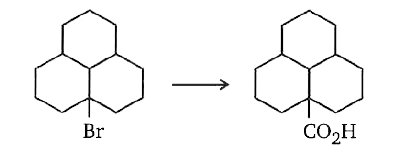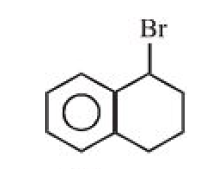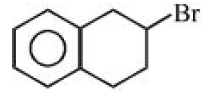The experimentakkt determind rate equiaction for the alkaline hydeolysis of RBr is given by:
Rate =K[RBr][θOH]
Which of the following staements is inconsists with these observations?
The reaction is first order with respect to RBr
The reaction is seound order overall
The reaction process is false.
The rate-determining step is bimolecular.
The correct Answer is:c
The reaction is wrong because alkaline hydrolysis of RX does not take place.
Topper's Solved these Questions
- AROMATIC COMPOUNDS AND ALKYL AND ARYL HALIDES Book:CENGAGE CHEMISTRYChapter:AROMATIC COMPOUNDS AND ALKYL AND ARYL HALIDES Exercise:Exercises Single Correct Answer Type
Explore 26 Videos
- AROMATIC COMPOUNDS AND ALKYL AND ARYL HALIDES Book:CENGAGE CHEMISTRYChapter:AROMATIC COMPOUNDS AND ALKYL AND ARYL HALIDES Exercise:Exercises Assertion-Resoning Type
Explore 1 Video
- AROMATIC COMPOUNDS AND ALKYL AND ARYL HALIDES Book:CENGAGE CHEMISTRYChapter:AROMATIC COMPOUNDS AND ALKYL AND ARYL HALIDES Exercise:Exercises Multiple Correct Answers Type
Explore 12 Videos
- APPENDIX INORGANIC VOLUME 2Book:CENGAGE CHEMISTRYChapter:APPENDIX INORGANIC VOLUME 2Exercise:Short Answer Type
Explore 179 Videos
- BIOMOLECULESBook:CENGAGE CHEMISTRYChapter:BIOMOLECULESExercise:Exercises Archives (Analytical And Descriptive)
Explore 8 Videos
Similar Questions
The experimental determined rate equiaction for the alkaline hydrolysis of RBr is given by:
Rate =K[RBr][θOH]
Which of the following staements is inconsists with these observations?
View SolutionIn the decompoistion of N2O5(g),
2N2O5(g)kobs−−→4NO2(g)+O2(g),
the observed rate law is given by
d[O2]dt=kobs[N2O5].
Which of the following proposed mechanics is conisstent with the rate law?
a. N2O5(g)k−−→N2O3(g)+O2(g)
b. N2(g)+NO3(g)k1−−→NO(g)+NO2(g)+O2(g)
View Solution
Knowledge Check
In the decompoistion of N2O5(g),
2N2O5(g)kobs−−→4NO2(g)+O2(g),
the observed rate law is given by
d[O2]dt=kobs[N2O5].
Which of the following proposed mechanics is conisstent with the rate law?AN2O5(g)k−−→N2O3(g)+O2(g)BN2O5(g)k2−−→NO2(g)+NO3(g)CN2(g)+NO3(g)k1−−→NO(g)+NO2(g)+O2(g)DNO3(g)+NO(g)k2−−→2NO2(g)Compare the two methods shown for the preparation of carboxylic acids:

Mehod 1 : RBrMg−−−−−−→diethyl etherRMgBr1.CO2−−−−→2.H3O+RCO2H
Method 2 : RBrNaCN−−−→RCNH2O,HCl−−−−−→heatRCO2H
Which one of the following statements correctly describes this conversion ?
 ABoth method 1 and method 2 are appropriate for carrying out this conversionBNeither method 1 nor method 2 is appropriate for carrying out this conversionCMethod 1 will workwell, but method 2 is not appropriateDMethod 2 will workwell, but method 1 is not appropriate
ABoth method 1 and method 2 are appropriate for carrying out this conversionBNeither method 1 nor method 2 is appropriate for carrying out this conversionCMethod 1 will workwell, but method 2 is not appropriateDMethod 2 will workwell, but method 1 is not appropriateWhich of the following is most reacting towards aqeous Ag⊕NOΘ3 or rate of SN1 reaction?
A B
B C
C D
D
If the rate of reaction, 2SO2(g)+O2(g)Pt−−→2SO3(g) is given by :
Rate=K[SO2][SO3]1/2
which statement are correct :
View SolutionThe gaseous decomposition of ozome
2O3→3O2
obeys the rate law r=−d[O3]dt=k[O3]2[O2]
Show that the following mechanims is consistent with the above rate law :
O3Keq⇐⇒O2+O (fast)
O+O3k1−−→2O2 (slow)
View SolutionFor the reaction
2Fe2++H2O2→2Fe3++2ɵOH, the rate of formation of Fe3+ is given by
Rate =k[Fe2+][H2O2]. Suggest a mechanism for the reaction and and indicate a probable rate-determining step.
View SolutionIf the rate of reaction, 2SO2(g)+O2(g)Pt−−→2SO3(g) is given by :
Rate=K[SO2][SO3]1/2
which statement are correct :
View SolutionIf the rate of reaction, 2SO2(g)+O2(g)Pt−−→2SO3(g) is given by:
Rate=K[SO2][SO3]1/2
which statements are correct?
View Solution
